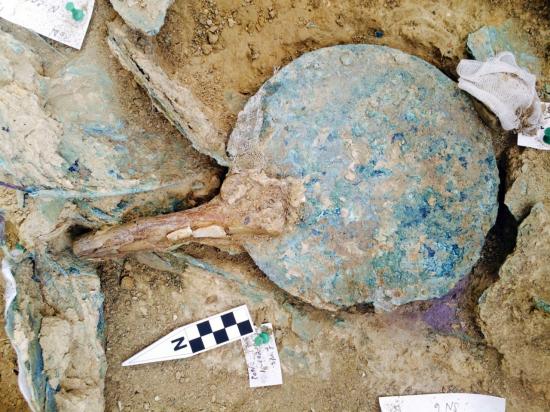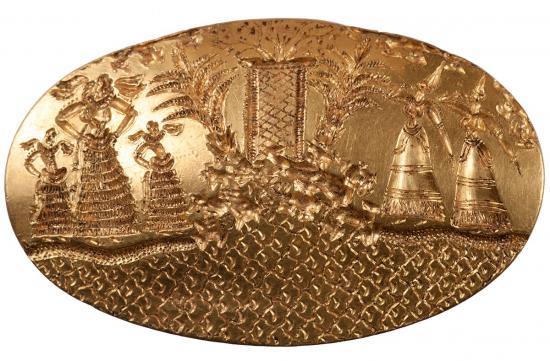A University of Cincinnati team's rare discovery of four gold rings in the tomb of a wealthy Bronze Age warrior undisturbed for 3,500 years prompts a new consideration of Greek history.
Rachel Richardson / University of Cincinnati
Source http://magazine.uc.edu/editors_picks/recent_features/lordoftherings.html
When University of Cincinnati researchers uncovered the tomb of a Bronze Age warrior — left untouched for more than 3,500 years and packed with a spectacular array of precious jewelry, weapons and riches — the discovery was hailed by experts as “the find of a lifetime.”
Now, only a year after archaeologists completed the excavation, new understandings of the artifacts — particularly the discovery of four golden rings — and the insights they provide to the origins of Greek civilization may prove to be the team's next big discovery.
Shari Stocker, a senior research associate in UC's Department of Classics, and Jack Davis, the university's Carl W. Blegen chair in Greek archaeology, will reveal the UC-based team's findings from the so-called "Griffin Warrior" grave Thursday, Oct. 6, at The American School of Classical Studies at Athens, Greece.
The husband-and-wife team's highly anticipated lecture is generating worldwide attention, including a feature in the New York Times.

UC's Shari Stocker, left, and Jack Davis, right, have worked in the Pylos region of Greece for 25 years. Stocker stands in the tomb of a Greek warrior uncovered by the UC-based team.
The 'find of a lifetime'
Stocker and Davis, along with other UC staff specialists and students, stumbled upon the remarkably undisturbed and intact tomb last May while excavating near the city of Pylos, an ancient city on the southwest coast of Greece.
Inside they discovered the well-preserved remains of what is believed to have been a powerful Mycenaean warrior or priest in his early- to mid-30s who was buried around 1500 B.C. near the archeological excavation of the Palace of Nestor.
Immortalized in Homer's "Odyssey," the large administrative center was destroyed by fire sometime around 1180 B.C., but remains the best-preserved Bronze Age palace on the Greek mainland. UC archaeologist Carl Blegen first discovered the Mycenaean ruins in 1939, where he unearthed a number of clay tablets written in Linear B script, the earliest known written form of Greek.
The warrior's tomb, hailed by the Greek Culture Ministry as the "most important to have been discovered [in continental Greece] in 65 years," revealed more than 2,000 objects arrayed on and around the body, including four solid gold rings, silver cups, precious stone beads, fine-toothed ivory combs and an intricately built sword, among other weapons.
The skeleton was dubbed the "Griffin Warrior" for the discovery of an ivory plaque adorned with a griffin — a mythical beast with the body of a lion and the head and wings of an eagle — buried with him.
The UC excavation is remarkable not just for the unparalleled riches discovered in the warrior-priest's tomb — to find an unlooted, intact grave is, in itself, a rare and historic feat — but for what the grave and its bounty reveals about the dawn of the Mycenaean civilization, a transformative period in the Bronze Age.

A mirror discovered in the tomb of a Greek warrior in southwest Greece refers to a scene of a goddess holding a mirror in one of four gold rings unearthed in the excavation by a team of UC researchers.
Unlocking an ancient mystery
A significant number of the artifacts found in the warrior's grave were made by Minoans, a culturally dominant civilization to the Mycenaeans that arose on the large island of Crete, southeast of Pylos. How then, the researchers puzzled, did a man from the Greek mainland accumulate such a large cache of Minoan-made riches?
One longstanding theory is that the Greeks of the Griffin Warrior's era — dubbed Mycenaean after their principal city, Mycenae — are thought to have imported or robbed the riches from the affluent non-Greek Minoan civilization on Crete.
"The grave was right around the time the Mycenaeans were conquering the Minoans," explained Stocker. "We know that there were extensive raids and shortly after the date of our grave, Minoan-Crete fell to the Mycenaeans."
But Stocker and Davis say that the artifacts found in the warrior's grave suggest a far greater cultural sharing between the ancient civilizations than just mere plunder. Instead, they insist, the carefully selected and hand-placed items reveal much about the heart of the relationship of the burgeoning mainland Greek culture to the more refined culture of Crete.

The excavation yielded the discovery of the second largest gold signet ring known in the Aegean world, which shows five elaborately dressed female figures gathered by a seaside shrine.
PART.2